|
|
Diamond Jubilee

|
|
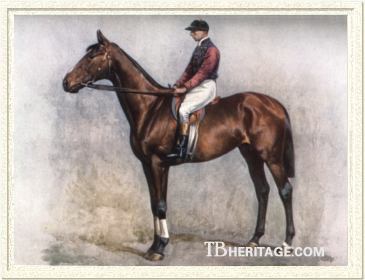 |
|
|
Diamond Jubilee went through his long life known as the younger brother of the great Persimmon. Both colts were bred and owned by HRH Albert Edward, Prince of Wales, later King Edward VII. Persimmon, the elder of the brothers by four years, captured the Derby, St. Leger, Eclipse Stakes, and Ascot Gold Cup, and at stud, was Britain's champion sire four times. Diamond Jubilee carved out a career that strongly rivaled that of his elder brother. He did Persimmon one better by capturing the English Triple Crown. At stud, Diamond Jubilee had some success in his native Britain, but excelled after he was exported to the Argentine, leading the sire list there four times and making an indelible impact on the breed in South America.
Diamond Jubilee was sired by the 6th Duke of Portland's St. Simon. Unbeaten on the racetrack, St. Simon was considered one of the greatest horses to ever race in Britain, despite not having run in any of the classic events. He was not nominated to the classics by his breeder, Prince Batthyany, because his dam, St. Angela (King Tom - Adeline), had produced nothing of merit from her previous five foals. During his long stud career at the Duke's Welbeck Abbey Stud, St. Simon was champion sire nine times, champion broodmare sire six times, and the sire of eight other classic winners in addition to the brothers Diamond Jubilee and Persimmon.
Perdita, the dam of Diamond Jubilee, did not seem destined to become one of England's extraordinary producers. She was bred decently enough, being by the fine cup horse Hampton, and out of Hermione, by Young Melbourne. The latter, a son of the great stallion Melbourne, got General Peel, a winner of the Two Thousand Guineas and Doncaster Cup, and was a good broodmare sire. Perdita's second dam, Teterrima, was a half-sister to Derby winner Wild Dayrell.
Perdita was bred and raced by John Frederick Vaughan Campbell, 2nd Earl Cawdor. She raced through the age of seven, winning seven races, including the Chesterfield Nursery Stakes, the Liverpool Cup, the Ayr Gold Cup, and the Great Cheshire Cup twice. Her durability brought her to the attention of John Porter, trainer for the Prince of Wales. Porter commented that she was "an angular sort of mare, but I could see she had good points, and was likely to develop into a nice broodmare." His argument won the day in his quest to obtain her for the Prince's broodmare band at Sandringham, even though the Prince's secretary, Sir Dighton Probyn, was less than enthusiastic at the price tag of 900 guineas.
After two matings to Barcaldine produced disappointing results, Perdita was sent almost exclusively to the court of St. Simon, as only two of her remaining seven foals were not sired by him. Of the five by St. Simon, three were exceptional. Florizel, foaled in 1891, became a top-class performer as he matured, capturing eleven races, including the Goodwood Cup, and was a very successful stallion. Persimmon, two years younger, was considered one of the greatest performers and sires of his era. Then there was Diamond Jubilee, foaled in the spring of Queen Victoria's Diamond Jubilee. His name was the suggestion of the Prince of Wales's wife, Princess Alexandra.
Perdita, was a high-strung and temperamental mare, and St. Simon was renowned for his highly electric temperament. The combination of these two mercurial individuals produced three different personalities in their three high-class sons. Florizel was blessed with a sensible personality; Persimmon was normally a kind horse which could display streaks of obstinacy when the mood struck him. Diamond Jubilee, however, inherited all the mental demons of his parents, for all through his long life he was famed and feared for his volatile personality.
Being a younger brother to the Prince's beloved Derby hero Persimmon and born in the jubilee year, as well as being an extremely handsome individual, the young colt was highly regarded and fussed over. Diamond Jubilee topped out at just under sixteen hands when he matured, and was a light bay, his black points including a black line which ran along his spine to the root of his tail. Diamond Jubilee's head and face were described by his trainer Richard Marsh as bold and intelligent. His hindquarters were powerfully built. He was not as rangy as the dark bay Florizel, and he was much more handsome than Persimmon, a bay who possessed a course head and large ears. In all, Diamond Jubilee was considered to be a finely conformed specimen of the thoroughbred.
Diamond Jubilee on the Turf
Like his elder brother, he was sent to be trained at Egerton House, Newmarket, by Richard Marsh, the Prince of Wales having transferred his horses from Porter to Marsh in 1892. The colt definitely had a sense of his own importance, which he displayed from his earliest training, Marsh reflecting "he would walk straight at you, and over you if you did not give way."
Diamond Jubilee was sent after the Coventry Stakes at Ascot for his two-year-debut. Diamond Jubilee was more concerned with ridding himself of Jack Watts, his jockey, than the race. During his antics in the paddock, a bystander was kicked in the hand by the royal color-bearer, and he went on to run unplaced in the race itself. Things were no better at Newmarket for the July Stakes. Diamond Jubilee dumped Watts from his back and galloped off. Eventually he was captured and his jockey put back up, but to no avail. Diamond Jubilee straggled home in last place.
For the Prince of Wales's Stakes at Goodwood, after several suggestions about what to do with the roguish colt, including castration. When it was discovered he was a ridgling, making castration a dangerous operation, it was decided to see if a different rider would help. Mornington Cannon was called upon to partner Diamond Jubilee. Though he failed to win, he was not disgraced, coming in second to Lord Rosebery's colt Epsom Lad. At Newmarket in the fall, Cannon rode Diamond Jubilee to a narrow victory in the Boscawen Stakes. Cannon was not available for the Middle Park Plate, and once again Diamond Jubilee was ridden by Jack Watts. Considering he had run so deplorably for Watts in his first two races, all connected with Diamond Jubilee were delighted he ran a respectable second to the brilliant gelding Democrat. The latter again took the measure of Diamond Jubilee in the Dewhurst Stakes, where the Prince of Wales's colt finished second.
Democrat never again regained his brilliant juvenile form, and later served as a charger for Lord Kitchener in India. Diamond Jubilee, off his moderate form at two, did not seem destined to emulate his elder brother Persimmon's spectacular three-year-old season. The trick was to get a rider he would willingly extend himself for. Clearly, for whatever reason, Diamond Jubilee detested Jack Watts, and he was none too fond of Mornington Cannon, either. He nearly killed the latter after he had dismounted the colt after a routine gallop by knocking him down and rolling on him. Cannon was less than enthusiastic about riding Diamond Jubilee again, and after considerable debate, it was decided to let nineteen-year-old Herbert Jones have the mount. His father, Jack Jones, had been a trainer of steeplechasers for the Prince, and young Herbert got his start working in the stable of flat runners under Marsh's supervision. Jones was kind and patient, and made every effort to work with the fiery Diamond Jubilee, the result being that Diamond Jubilee and the young man, barely out of his teens, came to a rapport.
The first race for the partnership of Diamond Jubilee and Herbert Jones resulted in a four length victory in the Two Thousand Guineas. Next came a short head victory in the ten furlong Newmarket Stakes as a prep for the 1-1/2 mile Derby Stakes. Diamond Jubilee's spirit did not diminish with the new rider, for he still bucked and reared and kicked whenever the notion took him, both at training and before his races. But the colt ran for Herbert Jones, and that was all that mattered.
On the all-important occasion of the Derby, there was some concern about how Diamond Jubilee would handle the pre-race excitement, and it was planned to send him straight to the start without participating in the parade. Then Marsh was informed that the Princess of Wales was anxious to see him in the parade, thus plans were changed with a certain feeling of apprehension. However, to the delight of Princess Alexandra and everyone else in the royal party, Diamond Jubilee behaved perfectly. He performed perfectly in the race, as well. He settled nicely for Jones, and stalked the leaders. After Tattenham Corner, Diamond Jubilee and American-bred and raced Disguise II went after the leader, Forfarshire. Disguise II did not have enough, and Diamond Jubilee and Simon Dale, owned by the Duke of Portland, fought it out for victory. In the end, Diamond Jubilee prevailed by a length and a half from Simon Dale, with Disguise II a further length behind in third place.
Diamond Jubilee was given a short rest and did not race at Royal Ascot, and came out again for the Princess of Wales's at Newmarket, Though he ran well, he could not successfully concede nearly twenty pounds to the filly Merry Gal, and lost to her by four lengths. Out next for the Eclipse Stakes at Sandown Park, Diamond Jubilee won smartly from Chevening, toting ten more pounds. Up next on the colt's dance card was the final classic, the St. Leger at Doncaster in September.
|
| 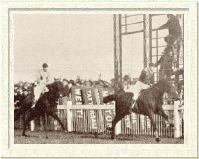
A comfortable win in the St. Leger
|
|
In the classic, Diamond Jubilee won by a comfortable length and a half margin. Indeed, he used up more energy before the race, for he acted up so badly, it took his trainer a full twenty minutes to get him saddled. Diamond Jubilee had one more race that season, the Jockey Club Stakes at Newmarket, where he ran a dull race to finish far behind Disguise II, whom he had beaten handily in the Derby.
At four, Diamond Jubilee never won a race. In the Princess of Wales's Stakes, he was second to Epsom Lad, and fourth to the same horse in the Eclipse Stakes. In his final career start, he was third in the Jockey Club Stakes, the race won by Pietermaritzburg, with Epsom Lad second.
|
Diamond Jubilee in the Stud
Diamond Jubilee was then retired to stand alongside his brothers Florizel and Persimmon at the Prince of Wales's stud at Sandringham. Both of Diamond Jubilee's older brothers were enjoying considerable success as stallions. Florizel could count himself the sire of a Derby in Volodyovski and a St. Leger winner in Doricles, while Persimmon, in his first crop, had sired the brilliant filly Sceptre, winner as a three-year-old of every classic except the Derby. Diamond Jubilee was in an unenviable position. Standing five seasons at Sandringham, Diamond Jubilee sired some good stakes winners, including two in his first crop, but he paled in comparison to the stud performance of his older brothers.
SANCY, foaled in 1903, was out of the Cabin Boy mare Dame Agneta. He was trained by Alec Taylor at Manton. As a three-year-old, Sancy captured the Prince of Wales's Stakes at Ascot not long after finishing a good second to Gorgos in the Two Thousand Guineas. At four, Sancy took both the Rous Memorial Stakes at Ascot and the Jockey Club Stakes at Newmarket. BELLEROPHON, a brown colt, was out of Rosicrucian's daughter Abanico. He won one race in six starts, but his lone victory came in Goodwood's Stewards' Handicap. Unfortunately, neither Sancy nor Bellerophon had notable stud careers.
Diamond Jubilee's 1904 crop included the bay filly JUBILEE, out of Jeunesse Doree, by Isinglass. Her biggest win came in the Park Hill Stakes at Doncaster as a three-year-old. She was not a success as a broodmare, but showed up in pedigrees later as the third dam of Canadian Derby winner Western Prince and Be Mine, a stakes winner in the U.S. in the 1930s for Colonel E. R. Bradley.
|
| 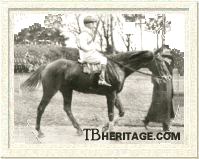
Weber
|
|
The colt WEBER came along in the 1905 foal crop. He was as beautifully bred as could be, his dam, Wheatley, being a daughter of the 1st Duke of Westminster's two champions Orme and Shotover. Despite her illustrious pedigree, Wheatley never made a mark for herself on the racecourse. She was acquired by Baron M. de Nexon and exported to France, where her son Weber was foaled. For his owner, Weber captured the Prix Flying Fox. Weber was an indifferent stallion at best, but he was the broodmare sire of the mare Alma Savoia, winner in 1929 of the Prix de Seine et Oise and third during her career in three other stakes, including the Prix Edmond Blanc and Prix Jacques le Marois.
|
Diamond Jubilee sired two stakes winners from his unions with the Gallinule mare Red Virgin, the colt QUEEN'S ADVOCATE and the filly ELIZABETTA. Queen's Advocate, the elder of the two, was foaled at J. Reid Walker's Joristown Stud Farm near Killuan, county Westmeath, Ireland, in 1904. Trained at Manton by Alec Taylor, the striking chestnut's claim to fame on the racecourse was his victory in the 1908 Princess of Wales's Stakes at Newmarket, the race his sire had twice failed to win. That season, Queen's Advocate was third in the Great Yorkshire Handicap, and the next season, second in the Liverpool Spring Cup. There are no records of Queen's Advocate siring any progeny.
|
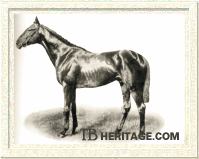
Queen's Advocate 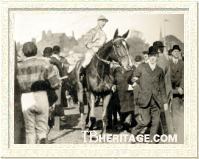
Elizabetta
|
|
His younger sister, ELIZABETTA, was foaled in 1906. Like her brother, she was trained for J. Reid Walker by Alec Taylor at Manton, and showed herself a filly with a proclivity for staying. A nice winner as a three-year-old, she blossomed at four, when she easily captured the Chester Cup, run over a distance of 2-1/4 miles and 147 yards. She was then third to Declare and Bridge of Earn in the 2-1/2 mile Ascot Stakes, and then rebounded to garner a victory in the Northumberland Plate at Newcastle at a distance of two miles and nineteen yards.
As a broodmare, ELIZABETTA came up with a colt almost as good as herself. That was the bay colt Inkerman, foaled in 1920 by the Polymelus stallion Invincible. At three, Inkerman captured the Jockey Club Stakes at Newmarket over that year's Derby winner Papyrus, with the filly Tranquil, winner that season of the One Thousand Guineas and St. Leger in third place. At four, Inkerman was third in the Ascot Gold Cup to the formidable French duo of Massine and Filibert de Savoie. Inkerman got some modest winners on the flat and over fences; one of his daughters produced the British-bred and American-raced gelding Cottesmore, who made a name for himself as a steeplechaser between 1939 and 1942, winning the American Grand National and the North American Steeplechase Handicap twice, and other good races over jumps.
|
Foaled the same year as Elizabetta was the chestnut filly BRIOLET, out of the Isinglass mare Bramble Jelly. As a four-year-old in 1910, Briolet was exported to Argentina, and there won the Premio Arenales. She did not make a name for herself as a producer.
The 1907 crop of Diamond Jubilee counted COUP DE VENT II as its best representative. This colt was bred and raced in France by Edmond Blanc. Though highly regarded, he never quite lived up to expectations, and his best performance was a third place in the Prix Noailles as a three-year-old behind Aloes III and Vellica. COUP DE VENT II did nothing at stud.
|
| 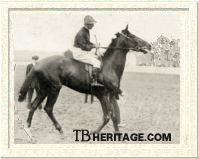
Coup de Vent
|
|
COUP DE VENT II was from the last crop Diamond Jubilee sired while standing in England. The Haras Las Ortigas stud near Morón in the Buenos Aires province of Argentina had lost its premier stallion Neapolis in 1905. Don Ignacio Correas, master of Haras Las Ortigas, came to England in hopes of finding a suitable replacement. He found nothing he liked until he came to Sandringham. He immediately became enamored of Diamond Jubilee, but was politely told by King Edward VII's racing manager, Lord Marcus Beresford, that the stallion was not for sale. However, since Diamond Jubilee's brother, Persimmon, held court as the premier stallion at Sandringham, it soon came to pass that Señor Correas got his way, and Diamond Jubilee became his property for 30, 000 guineas.
|
Diamond Jubilee was scheduled to embark for his new home in July, 1906, which allowed him to serve one more season at Sandringham and still get him to Argentina well before the start of the southern hemisphere breeding season in September.
His English Broodmare Daughters
From the daughters he left from his years of service in England, Diamond Jubilee was the broodmare sire of Most Beautiful. This filly, foaled in 1917, was by Great Sport, and out of Diamond Jubilee's daughter RAYON, who was out of the Donovan mare Asteria and foaled in 1903. Most Beautiful was victorious in the Nassau Stakes at Goodwood as a three-year-old, in which she defeated that season's One Thousand Guineas heroine Cinna, who finished third. Most Beautiful was also second in the Falmouth Stakes at Newmarket the same season. As a broodmare, Most Beautiful became the dam of Osiris, a Papyrus colt which won several major races, including the Woodcote Stakes, Newbury Spring Cup, and Earl of Sefton Plate. Exported to Canada, Osiris became the champion sire in Canada four times, in 1938, 1940, 1942, and 1947.
A half-sister to Most Beautiful was the Fugleman filly Maglona. This filly was highly inbred, as her sire Fugleman was by Diamond Jubilee's full brother Persimmon. Maglona made a name for herself in the broodmare paddocks as the dam of Moti Mahal, a The Tetrarch filly which won the prestigious Coronation Stakes at Ascot in 1926. Moti Mahal's son, a colt by Blandford named Bahrein, became a promising young sire in Hungary until he was stolen by the Red Army in 1945 and sent to Russia for a brief stud career there. Moti Mahal's daughter byGainsborough, Moti Begum, was a winner of the Ham Stakes and second to Myrobella in the National Breeders Produce Stakes and later produced Morogoro, by Felicitation. Morogoro suffered from severe "seconditis", as he was second to Hyacinthus in the Middle Park Stakes at two in 1940, then second to Lambert Simnel in the Two Thousand Guineas and second to Owen Tudor in the Derby Stakes the following season.
Diamond Jubilee had two major producers from his 1906 foal crop. The exquisitely bred MARIE LEGRAYE was out of the Springfield mare White Lilac, a full sister to One Thousand Guineas victress Briar-root. MARIE LEGRAYE became influential in Australian and New Zealand racing through the offspring of two of her daughters, After Glow and Grey Linnet, one of whom went to Australia, and the other to New Zealand. The former, After Glow, by Sunstar, produced four important Australian stakes winners: Epilogue, winner of the VRC St. Leger; Gleamlight, winner of SAJC S.A. Stakes and John Lewis Stakes; Royal Barb, winner of Launceston Cup and two editions of the TTC Newmarket Handicap; and The Dimmer, a gelding which captured the Perth Cup, Sydney Cup, AJC Plate, and Cox Plate.
Grey Linnet, by Thrush, was the daughter of MARIE LEGRAYE who wound up in New Zealand. She produced the colt Song Bird, winner of the Great Easter Stakes and Summer Handicap. Through her daughter Lady Egletine, Grey Linnet was the second dam of the half-sisters Green Linnet and Headlady. The former captured the WRC Telegraph Handicap at Trentham in 1932, while Headlady took the Wellington Stakes at Trentham the same season. Through another daughter, The Linnet, Grey Linnet was the second dam of New Zealand Oaks winner Idle Jest.
QUEEN MOTHER, the other producer from the 1906 crop, was a result of Diamond Jubilee's union with the Kendal mare Barbara. Both of QUEEN MOTHER'S two stakes performers were steeplechasers. Royal Falcon, foaled in 1923 by White Eagle, was a winner of the Champion Hurdle at Cheltenham. His year-younger full brother, Egremont, placed second in the Grand National at Aintree to Forbra in 1932. Royal Falcon was an entire horse, but accomplished nothing of note at stud, while his brother, Egremont, was gelded.
From the 1907 crop came VINAIGRETTE, out of Cellerette, by Prisoner. She produced the Santoi filly Antoinette, a remarkably durable filly which won sixteen of 120 starts and who became the dam and second dam of stakes winners in the United States, including Manhattan Handicap winner Count Stone, who was out of her daughter Nettie Stone.
But perhaps the most important producing daughter Diamond Jubilee left behind from his stud days in England was TAORMINA. She was out of the chestnut Bend Or mare Tay, and was foaled in Germany in 1905. Tay had been purchased carrying TAORMINA by R. Haniel von Rauch for his Gestüt Walburg stud. Taormina produced three exceptional performers of the German turf. The eldest, Traum, by Polymelus, was foaled in 1915. He captured the Preis des Winterfavoriten as a two-year-old and the Grosser Preis von Berlin at three. His stud career was short, but he sired two classic winners in the same season: in 1925, his daughter Melanie was victorious in the Henkel Rennen (German One Thousand Guineas) and the Preis der Diana (German Oaks), while his son Roland captured the Deutsches Derby. He was also the sire of Idomenus, a winner of the Sachsen Preis at Dresden.
Tulipan, TAORMINA'S daughter by Dark Ronald, was foaled in 1916. She took the Preis des Winterfavoriten at two, and at three garnered victories in the Henkel Rennen, Preis der Diana, and Deutschen Stutenpreis. She had no recorded foals.
Two years younger than Tulipan was her full brother Traumer, a winner of the Grossen Preis von Baden as a four-year-old. Sent to stud at the Harzburg Stud in Germany, Traumer was later purchased by American horseman Willis Sharpe Kilmer, who wished to use him as an outcross for his mares by Sun Briar. The cross achieved some success, for Traumer sired 1928 Pimlico Oaks winner Dark Magnet from the Sun Briar mare Sunmagne. Traumer's daughter Dark Loveliness, out of Sunny Love, by Sun Briar, earned but a pittance on the racetrack, but she became the dam of the Discovery filly Dark Discovery, winner of the Gallant Fox Handicap over males, and placed in such prestigious races as the Coaching Club American Oaks, Alabama Stakes, Ladies Handicap, and Saratoga Cup. Dark Loveliness became the second dam of important American stakes winner and sire Battlefield and was also an ancestress of English and Irish champion and international sire Storm Bird.
Diamond Jubilee in Argentina
Once Diamond Jubilee was set up as the premier stallion at Haras Las Ortigas, he enjoyed a tremendously successful and influential stud career. Diamond Jubilee lost none of his high mettle in his years off the track, and was still picky about who he would and would not let get close to him. When Señor Correas came to see his new acquisition upon his arrival at Haras Las Ortigas, the suspicious stallion promptly went for him, causing Correas to flee the angered horse's stall. Correas called for one of the grooms to bring him a large stick, with which he entered Diamond Jubilee's stall again and rapped on the floor several times. The horse was temporarily confused, and gave no trouble, and from then on, never attempted to ravage Correas again. He remained a demon to nearly everyone else until they day he died, though the stud manager, a man named Harry Garlick, earned the stallion's grudging respect and allowed that gentleman to handle him without too much fear of life and limb.
The Argentinean Diamond Jubilees came out running. Diamond Jubilee led the Argentinean sire list four times -- 1914, 1915, 1916, and 1921 -- and was in the top ten on nine more occasions. As a sire of broodmares, he was among the top ten for a decade, from 1922-1931, including second in 1929.
Haras Las Ortigas had many mares by Neapolis, and one of them was Argentina. The result of her union with Diamond Jubilee was the bay colt AS DE ESPADAS, foaled in 1908. He became the first classic winner for his sire when as a three-year-old, he captured the Gran Premio Nacional (Argentine Derby). AS DE ESPADAS stood at stud in Argentina and later in Brazil. His daughter, Welladay, was a top class stakes winner in Chile, winning ten races, including the Premio Garcia Mieres, Premio Apertura, Premio Copa Mercurio, and the Gran Premio Internacional.
The best producing daughter of AS DE ESPADAS was Soberana. She produced the filly Perlita, winner in Uruguay of the important Gran Premio Jose Pedro Ramirez. A son of Soberana, Coty, stood stud in Uruguay and sired Lord Coty, winner in 1943 of the Uruguayan Derby (the Gran Premio Nacional). Coty's daughter, Boina Roja, captured Uruguay's Polla de Potrancas (One Thousand Guineas).
From the Melton mare La Zingara, who had been exported from England to Haras Las Ortigas in 1907, Diamond Jubilee sired the colt LAST REASON, a foal of 1909. On the racecourse, LAST REASON was affectionately known as "El Rodillo" ("The Rolling Pin"), for his characteristic move which saw him collar and sweep by his opponents. During his career, LAST REASON won twenty-nine races, including the Clasico Coronel Pringles, Clasico Porteno, Clasico Clausura, Clasico America, Clasico Santiago Lawrie, and Clasico General Alvear. Like several other sons of Diamond Jubilee, LAST REASON was purchased for stud duty in Chile, arriving there at the age of eight in 1917. In Chile, LAST REASON was highly successful, leading the Chilean sire list three times -- in 1926, 1927, and 1928. He stood first at Haras San Miguel, through 1924, and then was sent to Haras Tiburones, standing there until his death at age seventeen in 1926. He sired 75 winners that earned the equivalent of over two million dollars.
The best performers by LAST REASON included Madrigal, a winner of seven races; Murga, winner of sixteen races; Barbaridad, winner of La Prueba, Premio Primavera, and Premio Guillermo Errazuriz Urmeneta; and Ardelion, winner of several important races, including the Premio Velocidad, Clasico Comparacion, La Huasca, and the Premio Santiago Garcia Mieres.
The best racing representative for Diamond Jubilee from his 1910 foal crop was the colt RICUARTE. He was out of the War Dance mare Rebelle, and captured Uruguay's Gran Premio Nacional in 1913. He sired no recorded foals.
|
| 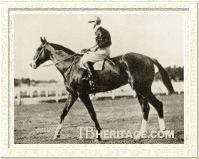
Smasher. Image courtesy Carlos Moore.
|
|
Diamond Jubilee was mated several times with the Orbit mare Sibila, one of the best fillies racing in Argentina in her day, victress in the Gran Premio Nacional and Gran Premio Carlos Pellegrini. Their unions produced two exceptionally talented performers: SACA CHISPAS and SMASHER. The former was victorious in the 1918 Gran Premio Jose Pedro Ramirez in Uruguay. His elder brother, SMASHER, captured the Argentinean Gran Premio Nacional in 1914, the first year his sire led the Argentinean general sire list. SACA CHIPAS amounted to very little as a stallion, and was once bred to his own dam. It was a devastating loss when SMASHER broke a leg while in training and had to be humanely destroyed.
|
Señor Correas was always looking to upgrade his broodmare band, and in 1907, he purchased in England a ten-year-old mare by Goldfinch named Celerina. She had produced nothing of any importance in England, but when bred to Diamond Jubilee in Argentina, she produced several foals, the best of which was the bay colt CAMPANAZO, foaled in 1912. During his racing career, CAMPANAZO won ten races. He was purchased for stud duty by Ramon Nieto, and sent to stand stud at Haras El Peral in Chile. Campanazo was enormously successful in Chile, and led the sire list there in 1929. His most notable winners included Anastasio, winner in 1926 of El Derby, Saint Leger, Internacional de Vina del Mar, and Clasico Espana in Chile; Brown Prince, winner of nineteen races, including the Premio Carlos Cousino, Premio Vicente Davila, and the Premio Cuerpo de Bamberos.
CAMPANAZO'S daughter, Caloria, was one of the best fillies of her era in South America, winner of El Derby in 1930, as well as the Polla de Potrancas, Gran Premio Nacional, Saint Leger, La Prueba, Internacional de Vina del Mar, and the Gran Premio Internacional.
Samuray, a son of CAMPANAZO, captured fourteen races, including the Premio Presidente Augusto B. Leguia; Ripley, another son, was a winner of six major stakes, including the Premio Jose Luis Walker, La Prueba, and the Guillermo Errazuiriz Urmeneta. Another good son of CAMPANAZO was Sin Sabor, winner of twelve races from 36 starts, his victories including two editions of the Valparaiso Sporting Club, the Jockey Club Argentino, and the Gran Premio Internacional. Sin Sabor had only a brief stud career, siring only twenty-six recorded foals, but he did get the filly Rosinara, winner of the El Ensayo in 1937, and the tough, well-traveled filly Shangay Lily. This filly won three major stakes races in her native Chile before being exported to the United States for the 1939 racing season. There she won the Delaware Handicap, placed second to the fine colt Eight Thirty in the Whitney Handicap at Saratoga and third to War Regalia in the Diana Handicap at the same track.
Yet another son of CAMPANAZO was Sol Naciente. Out of Saints Ferry, by Santoi, he was a winner of the Polla de Potrillos, while his sister, Sierra Leona, became the dam of 1936 El Ensayo victor El Mago.
Diamond Jubilee's 1914 foal crop was a superior one, with three outstanding performers, two of which were classic winners and the third classic-placed. The latter, the colt TAKECARE, was out of the Neapolis mare Elastica. He was second to the brilliant Botafogo in the Gran Premio Nacional as a three-year-old. At stud, Takecare sired nothing of exceptional merit, but he was the broodmare sire of the colt Sabaneta, winner of twenty-two races from ninety starts.
DALMACIA was a bay daughter of Diamond Jubilee out of Dinamita, by Old Man. She was bred by Haras El Moro. During her career on the turf, she won the classic Gran Premio Polla de Potrancas (Argentine One Thousand Guineas), Clasicos Olivarria, Gran Premio Ignacio Correas, and several other races. She had some success as a broodmare, her daughter Dinazarda, by Baratiere, taking the 1925 Gran Premio Protetora do Turfe in Brazil. Dalmacia's daughter, Daiquita, by Lord Basil, became the dam of Premio America winner Desplante.
|
| 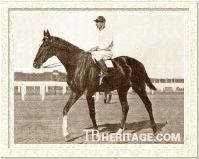
Moloch. Image courtesy Carlos Moore.
|
|
The third of this fine trio from the 1914 foal crop was MOLOCH, the best member of his year bar none. He was one of four brothers born from unions of Diamond Jubilee with the chestnut Neapolis mare Melilla, the others being MEHEMET ALI, MELIK and MUSTAFA. MOLOCH was the third brother of this quartet, foaled in 1914. He was bred and raced by Haras Las Ortigas. MOLOCH was a chestnut blessed with extreme speed, stamina, and durability. He won major stakes in Argentina and Brazil from the age of three through the age of seven. He made a total of fifty starts, and won exactly half of them. His victories included the Gran Premio Carlos Pellegrini, Gran Premio Palermo, Clasico America, Clasico Otono, Gran Premio de Honor, Clasico Brasil, and over a dozen additional stakes.
|
MOLOCH inherited a share of his sire's idiosyncratic temperament, for often, on the turn for the finish line, he would drift out to the outside rail and continue on to victory. An injury forced his retirement to stud alongside his sire at Haras Las Ortigas.
Tragically, MOLOCH died suddenly midway through his second season at stud. He did sire the good filly Night Tears, victress in the Premio de San Sebastian El Elcano and fourteen other races, as well as Prinaldo, a colt who captured several stakes, including the Clasico Rivadavia and Gran Premio Eliseo Ramirez. Another son of MOLOCH was Caimacan, which was raced in Chile, where he won several races, including the Club Hipico de Santiago, Gran Premio Vina del Mar, and Gran Premio Internacional. Caimacan made a good sire in Chile.
MOLOCH'S eldest brother was MUSTAFA, foaled in 1910. MUSTAFA won several races in Argentina before being sold to S. A. Williamson, owner of Haras Index at San Jose de Pocochay in Chile. Mustafa was at Haras Index for only a short time when Williamson died, necessitating the sale of his bloodstock holdings in 1920. MUSTAFA went to the Haras Mariman of partners Enrique Serrano Gundelach and Gustavo Ross Santa Maria. Later, he was moved to Haras Quilpue in Chile. MUSTAFA'S stud career, like that of his younger brother MOLOCH, was short-lived, for he died at the age of eleven in 1921 after siring only three crops. But the representatives of those three crops vaulted MUSTAFA to the top of the Chilean sire list in both 1923 and 1924. His best winners were Almodovar, winner of El Derby, El Ensayo, Gran Premio de Honor, and La Copa; Bombero, winner of the Saint Leger; Bricole, victress in the Chilean Polla de Potrancas; Portos, winner of the Gran Premio Internacional; and Urbion, winner of both El Ensayo and El Derby. |
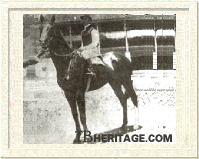
Mehemet Ali. Courtesy Julio Matano, Turfe Brasil
|
|
MELIK, foaled in 1912, was a winner of twelve races. He, too, wound up in Chile for stud service, and among his progeny was the good filly Quien Es. The youngest of the talented Diamond Jubilee's Melilla colts was MEHEMET ALI, foaled in 1919. His racing career took place in Brazil, where he won the Gran Premio Sao Paolo twice in 1923 and 1925. He remained in Brazil for stud duty, but never enjoyed the success of his elder brothers MOLOCH and MUSTAFA.
|
His Argentinian Daughters
As a sire of broodmares, Diamond Jubilee also enjoyed considerable success. He ranked among the top ten leading broodmare sires in Argentina for ten years, 1922 through 1931, and was ranked second in 1929.
Of the producing daughters of Diamond Jubilee in South America, some of the most notable were VIVANDERA, PAS SI MAL, and FALERNA. VIVANDERA was foaled in 1910 and out of Rose Royal, by Acheron. She produced the filly Vindicta, a winner of the Premio Ignacio Correas. Voluntaria, another daughter of Vivandera, produced the filly Viola, winner of the Grande Premio Diana in Brazil in 1939, 1940, and 1941.
PAS SI MAL was out of Saumur's daughter Pas Si Bet and was foaled in 1912. She was noted as the dam of Poor Chap, a colt by The Panther, which became a successful sire in Chile, leading the Chilean sire list in 1939. That was the year that Poor Chap's best son, Grimsby, captured the Chilean Triple Crown of El Ensayo, El Derby, and the Saint Leger.
FALERNA, foaled in 1913, was out of the Flying Fox mare Flitaway. She became the matriarch of a nice family of stakes winners, as her daughters produced Premio Bento Goncalues winner Falangista; At Home, a multiple stakes winner in Argentina; and Olimpo, a stakes winner and sire in the United States.
Diamond Jubilee died at Haras Las Ortigas at the age of twenty-six, on July 18, 1923. The old stallion retained his fiery temper and fierce independence right up until the end of his life. Always filled with loathing for having to be given oral medications, he became wise to nearly all tricks used to get the medicine into him, until stud manager Harry Garlick finally got the best of him by coating the end of a stick with the physic and putting the stick near the stallion's face, knowing full well the horse would take it between his ever-ready teeth. That the horse knew he had been tricked was evidenced by the fact that he stood stock still with his jaw clenched tightly for over two hours.
Always wary of strangers, Diamond Jubilee permitted only a handful of people to handle him without fear of life and limb. Thus it came as a complete shock when one evening, a tramp came by the stud, looking for a handout. Although ordered off the property, the man wound up in the stallion barn, in the box of Diamond Jubilee. He was found by Garlick, holding the stallion's head between his hands. When told to leave Diamond Jubilee's box, the man stroked the horse's neck and gave him a friendly pat on the rump, all to no ill effect.
Only months before his death, Diamond Jubilee charged out of his box in the stallion barn and galloped right off the farm, headed to he nearby town of Moron. In town, a small band of schoolboys recognized the stallion and tried to stop him by forming a human chain across the road. Diamond Jubilee kept coming, like a crazed bowling ball, aimed right for the line of little human bowling pins. The boys, with little time to spare, scattered out of the way as Diamond Jubilee plowed by. Diamond Jubilee was finally captured at the railroad station. He was returned safely to the farm, but not without protest, both along the way back, and for several hours after he was placed in the secure confinement of his box.
Diamond Jubilee, for all his demonic temper, was well worth the trouble throughout his life. He captured the English Triple Crown. He was a good sire in his native England who went on to become an outstanding sire in Argentina. All told, his progeny earned over $4.5 million in purses. Not only was he a champion sire in Argentina on four occasions, he sired sons who stood at stud in Brazil and Chile, including three sons who led the Chilean sire list a total of six times combined. He had descendants who won classics and major stakes in Argentina, Chile, Brazil, and Uruguay. Dealing with his cantankerous nature was indeed a small inconvenience by comparison.
--Liz Martiniak
|
|
|
|

